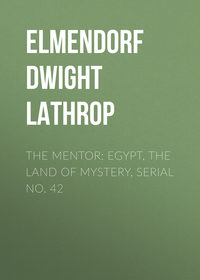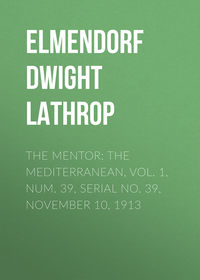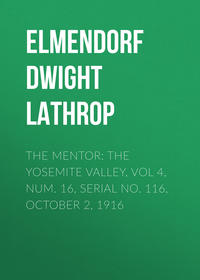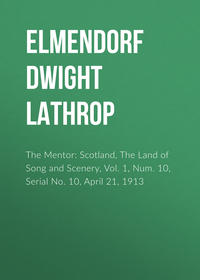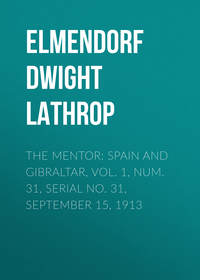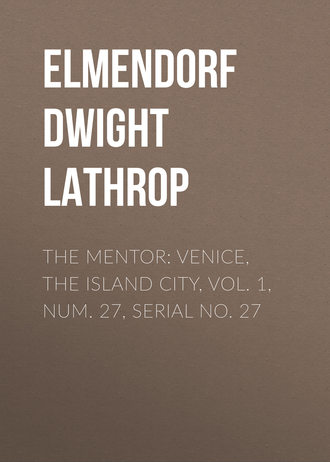
The Mentor: Venice, the Island City, Vol. 1, Num. 27, Serial No. 27
Here we are at the railway station. Now we turn and go down the other bank. We pass the broad mouth of the Cannaregio, and come to the gigantic Palazzo Vendramin-Calergi. Wagner, the great composer, died here. At the entrance to the Rio della Maddalena the canal makes an angle, and after passing many buildings and the mouth of the Rio di Noale we come to the Ca’ d’Oro. This is a very ornate building. Its name, the House of Gold, came from the fact that it was once gilded. Then we go by many palaces, and come to the Fondaco dei Tedeschi, or Guild of the German Merchants in Venice. An earlier Teutonic guild hall existed here from the thirteenth century. Venice imported oriental goods and passed them on to Germany. All the quarter round the Rialto Bridge was the business district, the Wall Street of Venice.
We pass under the Ponte di Rialto again, and after a little while arrive at the Palazzo Loredan, the most beautiful house on the Grand Canal. It is a Byzantine-Romanesque Venetian palace, with a distinct oriental feeling. Finally we come to a dainty little house, which the gondolier tells us is Desdemona’s Palace. This palace is named the Contarini-Fasan.
The rest of the canal is mainly occupied by hotels. Beyond the Hotel de l’Europe we come to the gardens of the Royal Palace. Our trip ends at the Bridge of Sighs.
The palaces on the Grand Canal bear witness to the early peace and civilization of Venice. Her houses were built for beauty and pleasure, when the nations of the earth were still building castles for defense.
VENICE
The Rialto Bridge
FIVEThe Ponte di Rialto, or Rialto Bridge, gets its name from the part of Venice it is in. This locality was the ancient city of Venice, and derives its name, Rialto, from Rivo Alto, as the land on the left of the canal was called. Even after the city expanded it continued to be the center of commerce and trade, the business heart of Venice. In this quarter were the Fabriche, or warehouses and custom houses, and many of the handsomest buildings, such as the Fondaco dei Turchi (Warehouse of the Turks) and the Fondaco dei Tedeschi (Warehouse of the Germans). It is this part of the city that Shakespeare means, when Shylock says:
“Signor Antonio, many a time and oftIn the Rialto you have rated meAbout my moneys.”The first Bridge of Rialto was built by an engineer named Barattieri in 1180. Up to this time a bridge of boats had been used. Barattieri’s bridge may be seen in the great picture of Carpaccio in the Accademia. In the sixteenth century there was a great competition for the honor of designing the new bridge. Fra Giocondo, Sansovino, Palladio, Vignola, and even Michelangelo himself contended. Antonio da Ponte obtained the coveted prize, and he began the present Ponte di Rialto in 1588 under Doge Pasquale Cicogna. At its completion it was very much criticized. Soon, however, this criticism was silenced, and on the engravings of the time it is called “Il Famoso Ponte” (The Famous Bridge). The span of the Rialto Bridge is 91 feet; its height is 24½ feet; its width, 72 feet.
The Annunciation on the bridge is by Girolamo Campagna. The angel is at one end of the span, and the Madonna is at the other end. The dove, flying toward the Madonna, forms the keystone of the bridge.
Along the footway of the bridge is a long line of shops.
Close to the Rialto Bridge is the Church of St. Giacomo di Rialto. This church is said to date from the foundation of the town. It possesses no remains of its antiquity. The campanile of the Church of St. Giacomo is a fine example. Built almost altogether of brick, the long lines of its arcades give an effect of great height. The details are good. Their character is Gothic.
Facing the church a statue of a hunchback, “Il Gobbo di Rialto,” supports a pillar. From the back of this statue the laws of the republic were proclaimed, and this was the center of business life in Venice.
And as we gaze upon all these relics of the past we agree with Lawrence Hutton:
“So strange and so strong is the power of fiction over truth, in Venice, as everywhere else, that Portia and Emilia, Cassio, Antonio, and Iago appear to have been more real here than are the women and men in real life. We see, on the Rialto, Shylock first, and then its history and associations; and the Council Chamber of the Palace of the Doges is chiefly interesting as being the scene of Othello’s eloquent defense of himself.”
VENICE
A Typical Venetian Canal
SIXIn Venice one takes a gondola as in America he takes a taxicab: with one difference, – after the gondola ride he still has some money left. A gondola is a long black skiff, with graceful lines and a swanlike prow sweeping up from the water. It is typically Venetian. It is admirably adapted to the work it has to do. There are only two points in all Venice where a gondola may not go even at low water, – one near the great theater of the Fenice, and the other near the Palazza Mocenigo at San Stae.
Two is the best number of passengers for a gondola. The rower is out of sight, behind. All is ideal. There is no noise, no dust, not even the feeling of motion, except the ripple of water past the bow.
The wood of which a gondola is built must be well seasoned and without knots. All gondolas turned out of one workshop are the same length. A new gondola is left unpainted for the first year. This is to prove its newness to any possible buyer. An unpainted gondola can easily be examined for knots. As soon as it is painted its value decreases.
The gondoliers become very attached to their own boats. They learn their peculiarities; for a gondola, like a person, has a character of its own.
Since the earliest days of Venice gondolas have been in use. Their present form has resulted from gradual development. The earliest authentic document relating to Venice mentions the light boats that were to the Venetians “as horses tied to the doors of their houses.” At first these boats were simple in construction; but in the sixteenth and seventeenth centuries the gondolas became very sumptuous. Finally, so luxurious did they become that they had to be regulated by law. Now they are longer and speedier, and are usually painted black.
There are about twenty ferries operating across the Grand Canal and the Giudecca. They resemble our cab service. The gondoliers also have guilds or unions. The police license the gondolas; but the real laws of the gondolier are those of his guild. Each guild has its own meeting place, where all questions of hours of work and choice of station are settled. If one member of the union becomes sick, he is cared for out of the public purse, and if he dies he is carried to the grave by his fellow members. These guilds are probably the last survivors of the old medieval crafts of Venice.
The skill of the average Venetian gondolier is marvelous. Rare indeed are collisions. These gondoliers are not the romantic heroes one may imagine them to be. They do not float in the moonlight singing serenades beneath their sweethearts’ windows. They are hardy fellows, thrifty, sober, and laborious, good husbands and fathers, matter-of-fact money makers.
One dollar and forty cents a day is the charge for a gondola and its gondolier in the season; at other times the price is forty cents less. A gondolier earns on an average sixty cents a day. This does not seem very much; but the gondoliers live fairly well, and even put money into the bank.
All the gondoliers of Venice are divided into two factions, the Nicolotti and the Castellani. The rivalry between these two is intense, and the question of supremacy was formerly settled by the knife. Nowadays, however, more peaceable but exciting races are the means. The Nicolotti wear a black sash and cap, and the Castellani wear red. There are four principal races a year. The first is rowed in May for a banner of red and gold; in August two pennons are rowed for, the white and gold, and the green; the blue banner is the prize in October.


